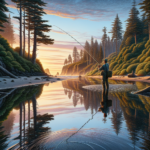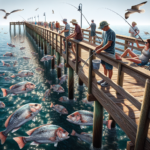Casting for Pike in Minnesota’s Lakes

Introduction
Imagine casting your line into the serene waters of a Minnesota lake, the early morning mist rising as you anticipate the thrill of a Northern Pike striking your lure. Minnesota, known as the “Land of 10,000 Lakes,” offers some of the best pike fishing opportunities in the United States. This article will delve into the intricacies of casting for pike in Minnesota’s lakes, covering everything from the best fishing techniques and gear to the top fishing spots and seasonal considerations.
Whether you’re a seasoned angler or a novice looking to catch your first pike, understanding the nuances of pike fishing in Minnesota can significantly enhance your experience. This guide aims to provide comprehensive insights into the techniques, species information, and locations that make Minnesota a pike fishing paradise.
Background/Context
Historical or Cultural Significance
Pike fishing has a rich history in Minnesota, dating back to the indigenous peoples who relied on these fish as a food source. Over the years, pike fishing has evolved into a popular recreational activity, drawing anglers from across the country. The Northern Pike, known for its aggressive behavior and formidable size, has become a symbol of Minnesota’s vibrant fishing culture.
Geographical Overview
Minnesota’s diverse landscape, characterized by its numerous lakes, rivers, and wetlands, provides an ideal habitat for Northern Pike. The state’s climate, with its cold winters and warm summers, creates a dynamic ecosystem that supports a variety of fish species. Key lakes such as Lake Mille Lacs, Leech Lake, and Lake of the Woods are renowned for their pike populations, offering anglers ample opportunities to test their skills.
Key Points/Details
Fishing Techniques
Technique Overview
When it comes to pike fishing, several techniques stand out:
- Spinnerbaits: Effective for covering large areas and attracting pike with their flash and vibration.
- Jerkbaits: Ideal for mimicking injured fish, enticing pike to strike.
- Live Bait: Using minnows or suckers can be particularly effective, especially in colder water.
When and Where to Use
Spinnerbaits are best used in shallow waters during the spring and fall when pike are more active. Jerkbaits work well in both shallow and deeper waters, making them versatile for different seasons. Live bait is most effective in colder months when pike are less aggressive and more likely to be attracted to an easy meal.
Recommended Gear
For pike fishing, a medium to heavy action rod paired with a high-capacity reel is recommended. Use braided line with a fluorocarbon leader to handle the pike’s sharp teeth. Popular lures include Mepps spinners, Rapala jerkbaits, and large minnows for live bait.
Species Information
Species Overview
The Northern Pike (Esox lucius) is a predatory fish known for its elongated body, sharp teeth, and aggressive nature. They prefer weedy areas in lakes and rivers where they can ambush prey. Pike are most active during cooler months and can be found in both shallow and deep waters depending on the season.
Best Practices
To successfully catch pike, focus on areas with abundant vegetation and structure. Use lures that mimic the natural prey of pike, such as smaller fish and frogs. Early morning and late evening are typically the best times to fish for pike, as they are more active during these periods.
Location Information
Top Fishing Spots
- Lake Mille Lacs: Known for its large pike population and accessible fishing spots.
- Leech Lake: Offers diverse fishing opportunities with numerous bays and inlets.
- Lake of the Woods: A premier destination for trophy pike fishing.
Regulations and Licenses
Anglers must adhere to Minnesota’s fishing regulations, which include specific seasons, size limits, and catch limits for pike. A valid fishing license is required for all anglers aged 16 and older. It’s essential to check the Minnesota Department of Natural Resources (DNR) website for the latest regulations and licensing information.
Seasonal Considerations
Seasonal Variations
Fishing conditions in Minnesota vary significantly throughout the year. In spring, pike are often found in shallow waters as they spawn. Summer sees pike moving to deeper, cooler waters. Fall is an excellent time for pike fishing as they become more active in preparation for winter. Winter ice fishing for pike is also popular, with anglers using tip-ups and live bait.
Best Times to Fish
The optimal times for pike fishing are early spring and late fall when water temperatures are cooler. Early morning and late evening are generally the best times of day to fish, as pike are more active during these periods.
Events and Tournaments
Event Overview
Minnesota hosts several fishing tournaments throughout the year, including events specifically for pike. The Minnesota Governor’s Fishing Opener is a notable event that marks the start of the fishing season. Other local tournaments offer opportunities for anglers to compete and showcase their skills.
Preparation Tips
To prepare for a fishing tournament, ensure your gear is in top condition and familiarize yourself with the tournament rules. Practice your casting techniques and study the fishing spots to gain an advantage. It’s also helpful to network with other anglers to share tips and strategies.
Tips and Best Practices
General Tips
- Always check the weather forecast before heading out.
- Use a variety of lures to determine what the pike are biting on that day.
- Practice catch and release to help maintain healthy fish populations.
Avoid Common Mistakes
- Not using a leader: Pike have sharp teeth that can easily cut through regular fishing line.
- Fishing in the wrong spots: Focus on areas with vegetation and structure where pike are likely to be hiding.
- Ignoring local regulations: Always stay updated on the latest fishing regulations to avoid fines and penalties.
Advanced Techniques
- Using electronics: Fish finders can help locate pike in deeper waters.
- Fly fishing for pike: An advanced technique that can be highly rewarding for experienced anglers.
- Night fishing: Pike can be more active at night, providing a unique fishing experience.
Gear and Equipment Recommendations
Essential Gear
- Medium to heavy action rod
- High-capacity reel
- Braided line with fluorocarbon leader
- Variety of lures (spinners, jerkbaits, live bait)
Optional Gear/Upgrades
- Fish finder
- Fly fishing gear
- Night fishing lights
Where to Buy or Rent
Local bait and tackle shops in Minnesota offer a wide range of fishing gear. Online stores such as Bass Pro Shops and Cabela’s also provide extensive selections. For those looking to rent equipment, many local shops near popular fishing spots offer rental services.
Safety and Conservation
Safety Tips
- Always wear a life jacket when fishing from a boat.
- Be aware of weather conditions and seek shelter if a storm approaches.
- Use caution when handling pike, as their teeth can cause injury.
Conservation Practices
- Practice catch and release to help sustain fish populations.
- Respect local wildlife and avoid disturbing natural habitats.
- Follow all fishing regulations and guidelines set by the Minnesota DNR.
Planning Your Trip
Accommodations
Minnesota offers a variety of accommodations near popular fishing spots, including lodges, cabins, and campgrounds. Resorts such as those on Lake Mille Lacs and Leech Lake provide comfortable lodging options with easy access to fishing areas.
Travel Tips
When planning your trip, consider the best routes to your chosen fishing spot. Many lakes are accessible by car, with well-maintained roads leading to boat launches and fishing piers. For remote locations, consider renting a boat or using a guide service to navigate the waters.
Additional Activities
In addition to fishing, Minnesota offers a range of outdoor activities such as hiking, bird watching, and boating. Many fishing spots are located near state parks and recreational areas, providing opportunities for family-friendly activities.
Frequently Asked Questions (FAQs)
What is the best time of year to fish for pike in Minnesota?
The best times are early spring and late fall when water temperatures are cooler, making pike more active.
Do I need a special license to fish for pike in Minnesota?
A general fishing license is required for all anglers aged 16 and older. Check the Minnesota DNR website for specific regulations and licensing information.
What type of bait is most effective for pike fishing?
Live bait such as minnows and suckers are highly effective, especially in colder water. Lures like spinners and jerkbaits also work well.
Are there any fishing tournaments for pike in Minnesota?
Yes, Minnesota hosts several fishing tournaments throughout the year, including events specifically for pike. Check local listings for dates and entry requirements.
Conclusion
Casting for pike in Minnesota’s lakes offers an exhilarating experience for anglers of all skill levels. By understanding the best techniques, gear, and locations, you can enhance your chances of landing a trophy pike. Remember to follow local regulations, practice conservation, and prioritize safety to ensure a rewarding and sustainable fishing adventure. So grab your gear, head to one of Minnesota’s beautiful lakes, and enjoy the thrill of pike fishing in the Land of 10,000 Lakes.




